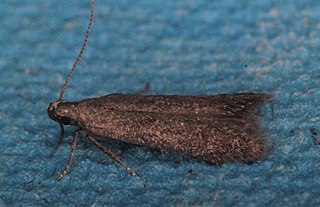
Polygonum arenastrum, commonly known as equal-leaved knotgrass, is a summer annual flowering plant in the knotweed family Polygonaceae. Other common names include common knotweed, prostrate knotweed, mat grass, oval-leaf knotweed, stone grass, wiregrass, and door weed, as well as many others. It is native to Europe and can be found on other continents as an introduced species and a common noxious weed. Knotweed was first seen in North America in 1809 and is now seen across much of the United States and Canada.
This article gives an overview of the plant communities formed by vegetation of open habitats in the British National Vegetation Classification system.
British NVC community OV4 is one of the open habitat communities in the British National Vegetation Classification system. It is one of six arable weed and track-side communities of light, less-fertile acid soils.

Polygonum aviculare or common knotgrass is a plant related to buckwheat and dock. It is also called prostrate knotweed, birdweed, pigweed and lowgrass. It is an annual found in fields and wasteland, with white flowers from June to October. It is widespread across many countries in temperate regions, apparently native to Eurasia, naturalized in temperate parts of the Southern Hemisphere.

Myricitrin is a plant compound, the 3-O-α-L-rhamnopyranoside of myricetin.
British NVC community OV9 is one of the open habitat communities in the British National Vegetation Classification system. It is one of eight arable weed and wasteland communities of fertile loams and clays.
British NVC community OV3 is one of the open habitat communities in the British National Vegetation Classification system. It is one of six arable weed and track-side communities of light, less-fertile acid soils.
British NVC community OV10 is one of the open habitat communities in the British National Vegetation Classification system. It is one of eight arable weed and wasteland communities of fertile loams and clays.
British NVC community OV11 is one of the open habitat communities in the British National Vegetation Classification system. It is one of eight arable weed and wasteland communities of fertile loams and clays.
British NVC community OV12 is one of the open habitat communities in the British National Vegetation Classification system. It is one of eight arable weed and wasteland communities of fertile loams and clays.
British NVC community OV15 is one of the open habitat communities in the British National Vegetation Classification system. It is one of two arable weed communities of light lime-rich soils.
British NVC community OV17 is one of the open habitat communities in the British National Vegetation Classification system. Although classed with communities OV15 and OV16 as an arable weed community of light lime-rich soils, it also shares many features with the communities classed as arable weed and wasteland communities of fertile loams and clays.

Martania taeniata, the barred carpet, is a moth of the family Geometridae. The species was first described by James Francis Stephens in 1831. It is found in large parts of the Palearctic realm.
British NVC community OV18 is one of the open habitat communities in the British National Vegetation Classification system. It is one of six communities characteristic of gateways, tracksides and courtyards.

Augasma aeratella is a moth of the family Coleophoridae. It is found in most of Europe. The habitat consists of open landscapes of forest-steppe and steppe biotopes.

Aviculin is a lignan. It is bio-active isolate of Pseudocydonia sinensis or Polygonum aviculare.

Avicularin is a bio-active flavonol isolated from a number of plants including Polygonum aviculare, Rhododendron aureum and Taxillus kaempferi.
Polygonum agreste is a species of flowering plant in the family Polygonaceae, native to Uzbekistan. It was first described by Georgji Sumnevicz in 1940.
Polygonum heterophyllumSol. ex Meisn. is a species of flowering plant in the family Polygonaceae, native to Uzbekistan, Turkmenistan and Tajikistan. It was first described by Daniel Solander in 1856.

Monochroa hornigi, the knotweed neb, is a moth of the family Gelechiidae. It was described by Otto Staudinger in 1883. It is found in most of Europe, European Russia, western and south-eastern Siberia, Transbaikalia, Korea and Japan (Hokkaido).







